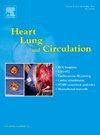Imaging and Surveillance of Chronic Aortic Dissection: Current Practice and Future Directions
IF 2.2
4区 医学
Q2 CARDIAC & CARDIOVASCULAR SYSTEMS
引用次数: 0
Abstract
Chronic aortic dissection is a complex disease with a heterogenous clinical course. Specialised imaging is necessary for the long-term surveillance of this disease to identify patients who meet the criteria for intervention, and to monitor surgically treated patients for complications. Whilst computed tomography and magnetic resonance imaging are the most widely utilised modalities, providing a high degree of anatomical detail and reproducible aortic measurements, they are not without significant limitations. These techniques cannot accurately predict patients that are at risk of late complications who may benefit from early intervention. Emerging techniques such as four-dimensional magnetic resonance imaging and computational fluid dynamics have identified multiple haemodynamic variables with potential prognostic value for identifying adverse events such as rupture, malperfusion, or aneurysmal degeneration, and may in the future become integrated into routine clinical practice. This review provides a detailed analysis of current diagnostic and surveillance imaging modalities in chronic aortic dissection and discusses future paradigms in aortic imaging to enable better prognostication and earlier intervention for high-risk patients.
慢性主动脉夹层的成像和监测:目前的实践和未来的方向。
慢性主动脉夹层是一种复杂的疾病,具有异质性的临床过程。对这种疾病的长期监测需要专门的影像学检查,以确定符合干预标准的患者,并监测手术治疗的患者是否有并发症。虽然计算机断层扫描和磁共振成像是最广泛使用的方式,提供了高度的解剖细节和可重复的主动脉测量,但它们并非没有明显的局限性。这些技术不能准确预测那些可能从早期干预中获益的晚期并发症风险患者。新兴技术,如四维磁共振成像和计算流体动力学,已经确定了多种血流动力学变量,对识别诸如破裂、灌注不良或动脉瘤变性等不良事件具有潜在的预后价值,并可能在未来整合到常规临床实践中。这篇综述详细分析了慢性主动脉夹层目前的诊断和监测成像模式,并讨论了主动脉成像的未来模式,以便更好地预测和早期干预高危患者。
本文章由计算机程序翻译,如有差异,请以英文原文为准。
求助全文
约1分钟内获得全文
求助全文
来源期刊

Heart, Lung and Circulation
CARDIAC & CARDIOVASCULAR SYSTEMS-
CiteScore
4.50
自引率
3.80%
发文量
912
审稿时长
11.9 weeks
期刊介绍:
Heart, Lung and Circulation publishes articles integrating clinical and research activities in the fields of basic cardiovascular science, clinical cardiology and cardiac surgery, with a focus on emerging issues in cardiovascular disease. The journal promotes multidisciplinary dialogue between cardiologists, cardiothoracic surgeons, cardio-pulmonary physicians and cardiovascular scientists.
 求助内容:
求助内容: 应助结果提醒方式:
应助结果提醒方式:


